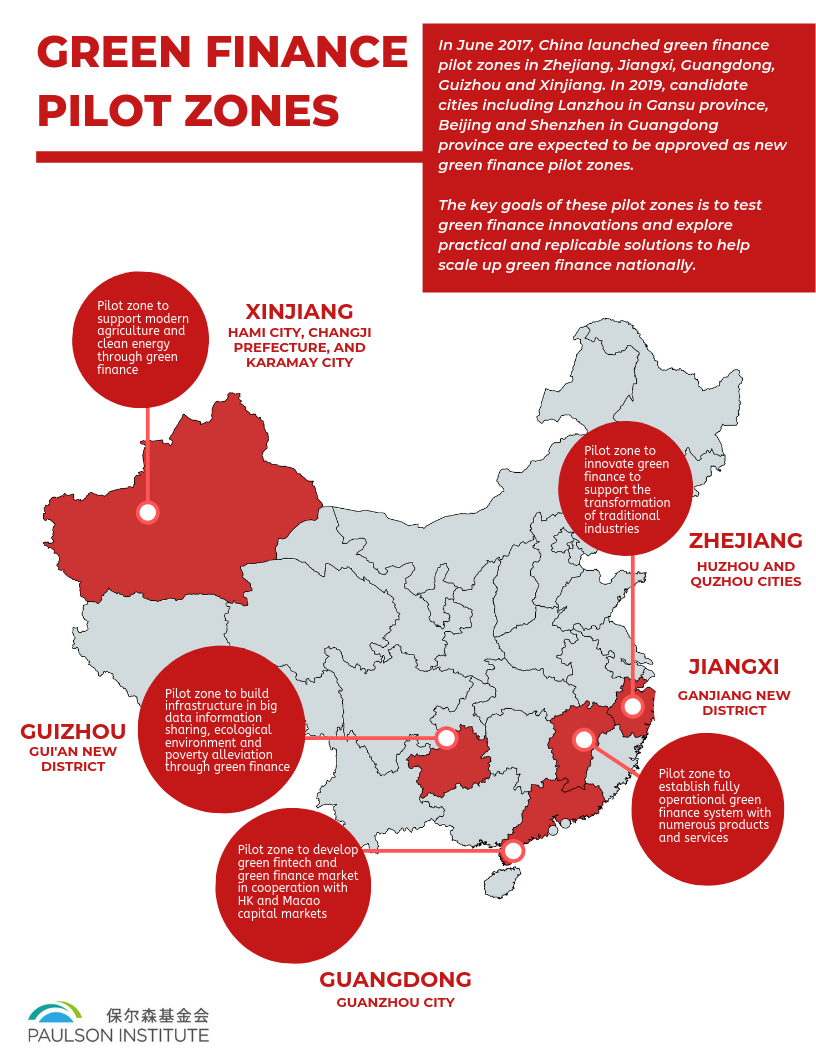The success of China’s special economic free trade zones in its opening up campaign is a tried and true recipe. Therefore, it is no surprise that China has established green finance pilot zones in the same fashion—a way to test specific policies before applying them nationally—but this time with an emphasis on experimenting with different green finance innovations.
In June 2017, China launched the first set of green finance pilot zones in Zhejiang, Jiangxi, Guangdong, Guizhou, and Xinjiang. This move as an important step toward the goal of building a robust national green finance system to help bankroll the country’s environmental protection goals. The experience gained in the local pilot zones help to inform potential successes and failures of green finance policies and to think through scale issues as policies are elevated nationally.

The key tasks for the pilot zones include enhancing the role of green finance in domestic financial institutions, promoting green credit, green insurance and green bonds, exploring establishment of the markets for environmental rights, strengthening government policies support, and developing green finance risk control mechanisms. It is expected that these innovations, policies, and practices tested in the zones can be applied nationally to unify green finance standards and improve the commercial sustainability of green finance.
Banks and financial institutions in the pilot zones have all been laboratories for testing a specific aspect of green finance. For instance, establishments in Guangzhou, as the capital of manufacturing hub Guangdong, were tasked with developing green credit facilities to curb emission and/or support energy conservation. In Guizhou, the emphasis was on green agriculture with regards to addressing the environmental waste issues in the largely bucolic province. To date, green finance zone experiences have been varied at best with the need to translate best practices and good policies for scale nationally.
Despite the mixed results, the most fruitful case to date is Huzhou in Zhejiang province. The city is where President Xi first introduced the concept that “green mountains and clear water are equal to mountains of gold and silver” to underpin the country’s environmental goals. The jury is still out on Huzhou’s green finance future, but it already some key success pillars in place including a sound governance system to encourage green finance development, a growing demand for green industry, and an established working relationship with China’s Green Finance Committee for technical support.
Since 2017, Huzhou has played a pioneering role in green finance development including constructing a statistical system for green finance, an IT-based green financing platform, and a green finance evaluation standards and rating system applicable for green companies, projects, banks and services. As of June 2018, Huzhou’s green credit volume reached 22% of total financial credit issued by institutions in the city—that is about 9% higher than the national average due to the green credit policy incentives promoted in the city as a green finance pilot. As a result, the Bank of Huzhou has applied to be the 3rd Equator Principles Financial Institution in China, following the Industrial Bank and the Bank of Jiangsu.
In 2019, the State Council is expected to officially issue the list of the provinces and cities in China that would comprise the second tranche of green finance pilot zones. Some cities, such as, Lanzhou in Gansu province, Beijing, and Shenzhen in Guangdong province,have released their local plans for green finance development. It is likely they will be potential candidates on the list with Lanzhou as a top candidate due to its strategic location on China’s economic silk road. The new green finance pilot zones will likely endeavor to scale up green finance by improving green finance standards, further innovating green finance products and services, and finding ways to strengthen risk control mechanisms.
With the innovations tested and best practices gained in the old and new pilot zones, it should be an active year ahead for green finance in China and one that we will continue to monitor.


